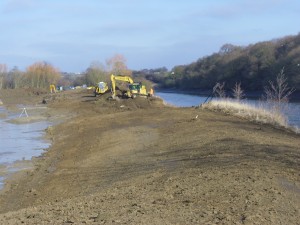Sneak preview of new saline lagoon
Visitors are invited to join a special guided tour of WWT Washington Wetland Centre’s new saline lagoon this weekend, before the habitat is flooded and an array of local wildlife begins to move in.
The £100,000 project, funded by the SITA trust, is due for completion in March and is designed to improve the nature reserve’s biodiversity by strengthening its connection to the River Wear.
As part of the development, a breach has been made in WWT Washington’s river bank, allowing tidal water to flood in during spring high tide (next expected in early March).
Even when the tide is low however, the land will still retain pools of water and this brackish habitat – a mixture of fresh and sea water – will provide the perfect salinity levels for a unique range of wetland species.
The spoil from the excavation (some 100,000 cubic metres or 14,285 Transit van-loads!) has been deposited at either end of the lagoon, raising the area substantially and creating fantastic vistas across the habitat itself and down along the Wear.
Mud islands have also been built up along the middle of the lagoon. These have been topped with pea gravel and will provide essential nesting habitat for wading birds.
And at the top of the meadow overlooking the lagoon, a new meandering nature trail is to be designed, which visitors can wander along from Hawthorn Wood before emerging at a viewing point. The hedgerows along the trail are to be left partially in-tact, creating a subtle screen that will allow the public to get close to the wildlife below without disturbing it.
The preview tour takes place on Saturday 25 February. Sturdy footwear/wellies will be needed due to the muddy landscape and unfortunately, the event is unsuitable for wheelchairs. We apologise for any inconvenience that this may cause. Meet in the picture window at 2pm. No need to book and cost is included in admission.
New species expected to be attracted to the lagoon -
Birds:
Saltmarshes are important feeding grounds for migrating and wintering bird species including wigeon, teal, barnacle goose, goosander, goldeneye, grebe, kingfisher and cormorant, as well as a host of wading species including oystercatcher, ringed plover, lapwing, dunlin, redshank, woodcock and snipe.
Once the saltmarsh plants have had time to establish, their seeds may attract feeding flocks of twite and snow bunting. The lagoon should also provide some ice-free areas for curlew to roost safely if Wader Lake freezes.
Spring/summer birds that should be attracted to the lagoon include avocet, while common tern may start to colonize the lagoon by nesting on the newly-created shingle islands.
Apart from the new nature trail, White Meadow will remain relatively undisturbed, providing nest sites for lapwing, oystercatcher and redshank.
The yellow wagtail, which is a scarce summer visitor and rarely recorded at WWT Washington, could be tempted to stop off and hunt for invertebrates along the edges of the lagoon.
Despite the current disturbance from the diggers, some birds are actually taking advantage of the lagoon as it is being transformed. Black-headed gulls are searching for earthworms in the freshly-excavated soil, while grey wagtail are making the most of any disturbed invertebrates and kestrel are hunting across White Meadow for small mammals that have been flushed out.
Mammals:
Since 1996, otters have successfully colonized the River Wear and are now widespread on the river system, due in large part to better water quality and fish populations.
Also welcome would be brown hare (in the meadows and hedgerows), bats (feeding over the lagoon) and even the odd seal.
Fish:
The River Wear supports important stocks of migratory salmonids (salmon and trout) and in recent years sea trout have been increasing.
Non-migratory fish communities include brown trout, grayling, lamprey and a range of coarse fish species such as dace, chub, gudgeon, bream, eel, stone loch, minnow and bullhead. The lagoon will regularly be topped up with water from the River Wear, allowing the fish to enter the lagoon.
Plants:
Plant life is key to a healthy and successful saltmarsh. Species that we hope to establish include glasswort, falsefox sedge, sea clubrush, sea aster, grass sea milkwort, greater sea spurrey, sea thrift, sea plantain, hastate orache, sea couch, sea lavender, juncus maritimus (sea rush), puccinellia maritime (common saltmarsh grass).




